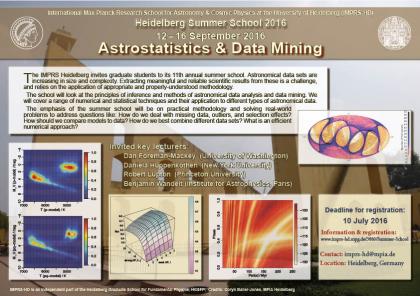

This webpage provides information for the 11th Heidelberg Summer School on the topic
The school took place September 12-16, 2016 in the Max Planck House in Heidelberg, Germany.
This school was the 11th in a series of Summer Schools with the previous topics:
2006: The Physics of the Interstellar Medium,
2007: The Milky Way Galaxy,,
2008: The Art & Craft of Astronomical Instrumentation,
2009: Statistical Inferences from Astrophysical Data,
2010: First Stars and Cosmic Reionization,
2011: Characterizing Exoplanets - from Formation to Atmospheres,
2012: Computational Astrophysics,
2013: High Energy Astrophysics,
2014: Frontiers of Stellar Structure & Evolution,
2015: Dynamics of the Interstellar Medium and Star Formation,
2016: Astrostatistics and Data Mining,
2017: Compact Objects & Gravitational Waves,
2018: Gaia Data & Science, ...
Max Planck Institute for Astronomy, Max Planck Institute for Nuclear Physics
Astronomisches Rechen-Institut, Institute for Theoretical Astrophysics, Landessternwarte Koenigstuhl, Heidelberg Institute for Theoretical Studies.
Scientific organizing committee: Coryn Bailer-Jones (MPIA, Heidelberg).
Daniela Huppenkothen (New York University)
Robert Lupton (Princeton University)
Benjamin Wandelt (Institute for Astrophysics, Paris)
Astronomical data sets are increasing in size and complexity.
Extracting meaningful and reliable scientific results from these is a challenge, and relies on the application
of appropriate and properly-understood methodology.
The school has looked at the principles of inference and methods of astronomical data analysis and data mining.
A range of numerical and statistical techniques was covered as well as their application to different types of
astronomical data.
The emphasis was on practical methodology and solving real-world problems to address questions like:
How do we deal with missing data, outliers, and selection effects?
How should we compare models to data?
How do we best combine different data sets?
What is an efficient numerical approach?
Topics that were covered include:
- time series analysis, including quasi-periodicity and stochastic processes
- low photon count data
- multi-dimensional interpolation
- image processing: optimal addition and subtraction
- non-Gaussian and correlated noise
- Bayesian model comparison vs. orthodox hypothesis testing
- MCMC methods
- hierarchical models
- parameter estimation in high dimensional problems
- novelty detection
- handling and visualizing large or multi-dimensional data sets
1. A series of structured lectures given by the four lecturers.
2. Computer-based exercises based on the topics given in the lectures. Some lecturers will integrate the exercise sessions into their lectures.
3. Presentations by other speakers on the application of astrostatistics to open scientific problems.
4. A social program to enable and encourage scientific interaction between students, lecturers and speakers.

